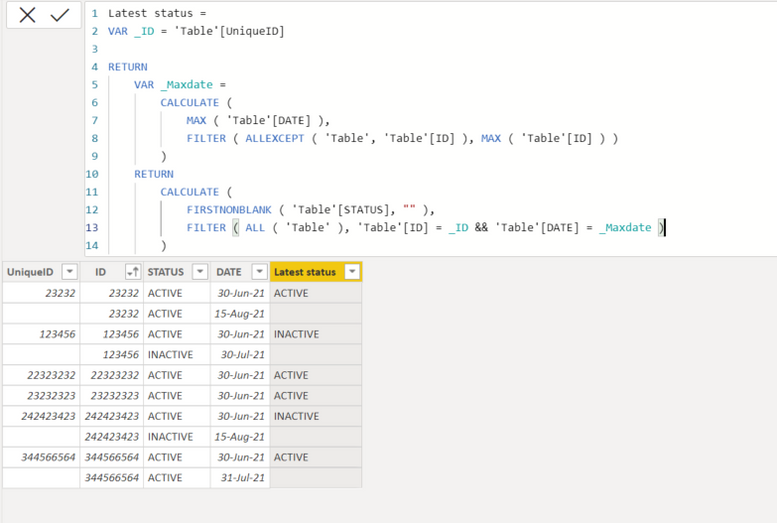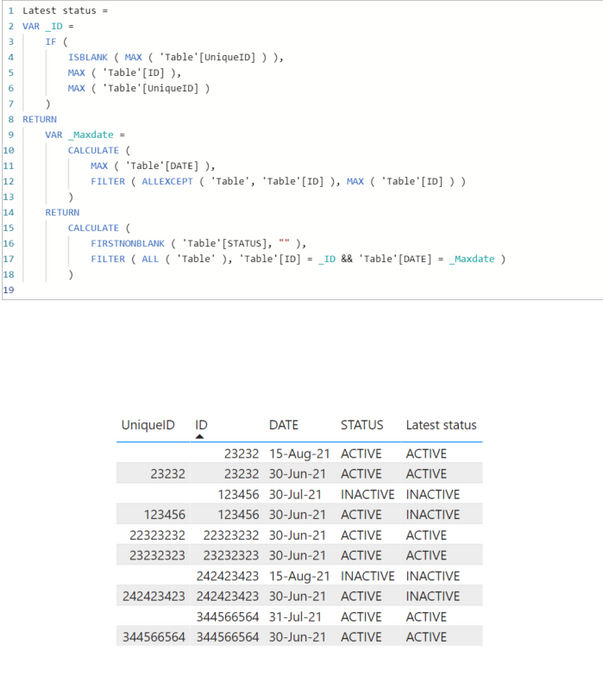- Power BI forums
- Updates
- News & Announcements
- Get Help with Power BI
- Desktop
- Service
- Report Server
- Power Query
- Mobile Apps
- Developer
- DAX Commands and Tips
- Custom Visuals Development Discussion
- Health and Life Sciences
- Power BI Spanish forums
- Translated Spanish Desktop
- Power Platform Integration - Better Together!
- Power Platform Integrations (Read-only)
- Power Platform and Dynamics 365 Integrations (Read-only)
- Training and Consulting
- Instructor Led Training
- Dashboard in a Day for Women, by Women
- Galleries
- Community Connections & How-To Videos
- COVID-19 Data Stories Gallery
- Themes Gallery
- Data Stories Gallery
- R Script Showcase
- Webinars and Video Gallery
- Quick Measures Gallery
- 2021 MSBizAppsSummit Gallery
- 2020 MSBizAppsSummit Gallery
- 2019 MSBizAppsSummit Gallery
- Events
- Ideas
- Custom Visuals Ideas
- Issues
- Issues
- Events
- Upcoming Events
- Community Blog
- Power BI Community Blog
- Custom Visuals Community Blog
- Community Support
- Community Accounts & Registration
- Using the Community
- Community Feedback
Register now to learn Fabric in free live sessions led by the best Microsoft experts. From Apr 16 to May 9, in English and Spanish.
- Power BI forums
- Forums
- Get Help with Power BI
- Desktop
- Need help with power query or DAX formula
- Subscribe to RSS Feed
- Mark Topic as New
- Mark Topic as Read
- Float this Topic for Current User
- Bookmark
- Subscribe
- Printer Friendly Page
- Mark as New
- Bookmark
- Subscribe
- Mute
- Subscribe to RSS Feed
- Permalink
- Report Inappropriate Content
Need help with power query or DAX formula
Hi,
I have 4 columns in a table.
First Column is a unique ID, Second column is the ID (same as first column but has multiple entries),
thrid column is the status and fourth column is date.
I need to take the unique ID, compare and filter the second column. If there are multiple values then I need the status of the latest date and print it in a new fifth column.
| UniqueID | ID | STATUS | DATE |
| 123456 | 123456 | ACTIVE | 30-Jun-21 |
| 344566564 | 344566564 | ACTIVE | 30-Jun-21 |
| 242423423 | 242423423 | ACTIVE | 30-Jun-21 |
| 23232 | 23232 | ACTIVE | 30-Jun-21 |
| 22323232 | 22323232 | ACTIVE | 30-Jun-21 |
| 23232323 | 23232323 | ACTIVE | 30-Jun-21 |
| 123456 | INACTIVE | 30-Jul-21 | |
| 344566564 | ACTIVE | 31-Jul-21 | |
| 242423423 | INACTIVE | 15-Aug-21 | |
| 23232 | ACTIVE | 15-Aug-21 |
Can you please help me to achieve the result. Thank you
Solved! Go to Solution.
- Mark as New
- Bookmark
- Subscribe
- Mute
- Subscribe to RSS Feed
- Permalink
- Report Inappropriate Content
Hi @manipepsi ,
Please try to deal with it in Power Query Editor with the below applied codes and check whether you still get the errpr message with "there is no enough memory"... You can find the details in the attachment.
let
Source = Table.FromRows(Json.Document(Binary.Decompress(Binary.FromText("i45WMjQyNjE1U9JBMBydQzzDXIEMYwNdr9I8XSNDpVidaCVjE6C0mamZCUgGiY1DuZEJEBoDEVAGmY1LuTEQgpRCaVzKwPIQlQgmPjONIS5AMHEoRg4BTz9URTlIirB73RBNFbKPkUwzNNV1LE1HVofuAyQVsQA=", BinaryEncoding.Base64), Compression.Deflate)), let _t = ((type nullable text) meta [Serialized.Text = true]) in type table [UniqueID = _t, ID = _t, STATUS = _t, DATE = _t]),
#"Changed Type" = Table.TransformColumnTypes(Source,{{"UniqueID", Int64.Type}, {"ID", Int64.Type}, {"STATUS", type text}, {"DATE", type date}}),
#"Grouped Rows" = Table.Group(#"Changed Type", {"ID"}, {{"Latest date", each List.Max([DATE]), type nullable date}, {"Details", each _, type table [UniqueID=nullable number, ID=nullable number, STATUS=nullable text, DATE=nullable date]}}),
#"Expanded Details" = Table.ExpandTableColumn(#"Grouped Rows", "Details", {"UniqueID", "STATUS", "DATE"}, {"UniqueID", "STATUS", "DATE"}),
#"Added Custom" = Table.AddColumn(#"Expanded Details", "Latest Status", each if [DATE]=[Latest date] then [STATUS] else null),
#"Removed Columns" = Table.RemoveColumns(#"Added Custom",{"Latest date"})
in
#"Removed Columns"The detailed steps as below:
1. Get the latest date group by ID and expand the details
2. Add conditional column to get the status with latest date
3. Remove the latest date column
Best Regards
If this post helps, then please consider Accept it as the solution to help the other members find it more quickly.
- Mark as New
- Bookmark
- Subscribe
- Mute
- Subscribe to RSS Feed
- Permalink
- Report Inappropriate Content
Hi @manipepsi ,
Please try to deal with it in Power Query Editor with the below applied codes and check whether you still get the errpr message with "there is no enough memory"... You can find the details in the attachment.
let
Source = Table.FromRows(Json.Document(Binary.Decompress(Binary.FromText("i45WMjQyNjE1U9JBMBydQzzDXIEMYwNdr9I8XSNDpVidaCVjE6C0mamZCUgGiY1DuZEJEBoDEVAGmY1LuTEQgpRCaVzKwPIQlQgmPjONIS5AMHEoRg4BTz9URTlIirB73RBNFbKPkUwzNNV1LE1HVofuAyQVsQA=", BinaryEncoding.Base64), Compression.Deflate)), let _t = ((type nullable text) meta [Serialized.Text = true]) in type table [UniqueID = _t, ID = _t, STATUS = _t, DATE = _t]),
#"Changed Type" = Table.TransformColumnTypes(Source,{{"UniqueID", Int64.Type}, {"ID", Int64.Type}, {"STATUS", type text}, {"DATE", type date}}),
#"Grouped Rows" = Table.Group(#"Changed Type", {"ID"}, {{"Latest date", each List.Max([DATE]), type nullable date}, {"Details", each _, type table [UniqueID=nullable number, ID=nullable number, STATUS=nullable text, DATE=nullable date]}}),
#"Expanded Details" = Table.ExpandTableColumn(#"Grouped Rows", "Details", {"UniqueID", "STATUS", "DATE"}, {"UniqueID", "STATUS", "DATE"}),
#"Added Custom" = Table.AddColumn(#"Expanded Details", "Latest Status", each if [DATE]=[Latest date] then [STATUS] else null),
#"Removed Columns" = Table.RemoveColumns(#"Added Custom",{"Latest date"})
in
#"Removed Columns"The detailed steps as below:
1. Get the latest date group by ID and expand the details
2. Add conditional column to get the status with latest date
3. Remove the latest date column
Best Regards
If this post helps, then please consider Accept it as the solution to help the other members find it more quickly.
- Mark as New
- Bookmark
- Subscribe
- Mute
- Subscribe to RSS Feed
- Permalink
- Report Inappropriate Content
- Mark as New
- Bookmark
- Subscribe
- Mute
- Subscribe to RSS Feed
- Permalink
- Report Inappropriate Content
Thanks @VahidDM for the quick reply.
I have still 2 questions:
1) In the "Latest Status" whether it is possible to have the latest status (Inactive, active etc.) only for "Unique ID" ?
Meaning: What I need is the latest status for every Unique ID so that I can filter the latest statuses which I need.
In this solution I cannot able to filter 2 statuses and get the unique IDs of those.
2) Whether it is possible to have "Latest Status" as a column and not as a measure?
Can you please also help with these questions?
Thanks in advance!!
- Mark as New
- Bookmark
- Subscribe
- Mute
- Subscribe to RSS Feed
- Permalink
- Report Inappropriate Content
Hi @manipepsi
Yes, It is.
Add a new column and try the below measure:
Latest status =
VAR _ID = 'Table'[UniqueID]
RETURN
VAR _Maxdate =
CALCULATE (
MAX ( 'Table'[DATE] ),
FILTER ( ALLEXCEPT ( 'Table', 'Table'[ID] ), MAX ( 'Table'[ID] ) )
)
RETURN
CALCULATE (
FIRSTNONBLANK ( 'Table'[STATUS], "" ),
FILTER ( ALL ( 'Table' ), 'Table'[ID] = _ID && 'Table'[DATE] = _Maxdate )
)The output will be as below:
Did I answer your question? Mark my post as a solution!
Appreciate your Kudos !!
- Mark as New
- Bookmark
- Subscribe
- Mute
- Subscribe to RSS Feed
- Permalink
- Report Inappropriate Content
HI @VahidDM
Thanks for your quick response.
I tried your solution but I got the error "There is no enough memory to complete this operation" .
I have 16GB of RAM but my data has 300K rows.
Whether there is any possibility to have a memory efficient solution?
Thank you
- Mark as New
- Bookmark
- Subscribe
- Mute
- Subscribe to RSS Feed
- Permalink
- Report Inappropriate Content
Hi @manipepsi
Please try this measure:
Latest status =
VAR _ID =
IF (
ISBLANK ( MAX ( 'Table'[UniqueID] ) ),
MAX ( 'Table'[ID] ),
MAX ( 'Table'[UniqueID] )
)
RETURN
VAR _Maxdate =
CALCULATE (
MAX ( 'Table'[DATE] ),
FILTER ( ALLEXCEPT ( 'Table', 'Table'[ID] ), MAX ( 'Table'[ID] ) )
)
RETURN
CALCULATE (
FIRSTNONBLANK ( 'Table'[STATUS], "" ),
FILTER ( ALL ( 'Table' ), 'Table'[ID] = _ID && 'Table'[DATE] = _Maxdate )
)the output will be as below:
Did I answer your question? Mark my post as a solution!
Appreciate your Kudos !!
Helpful resources

Microsoft Fabric Learn Together
Covering the world! 9:00-10:30 AM Sydney, 4:00-5:30 PM CET (Paris/Berlin), 7:00-8:30 PM Mexico City

Power BI Monthly Update - April 2024
Check out the April 2024 Power BI update to learn about new features.

| User | Count |
|---|---|
| 105 | |
| 101 | |
| 79 | |
| 72 | |
| 64 |
| User | Count |
|---|---|
| 141 | |
| 107 | |
| 100 | |
| 82 | |
| 74 |





